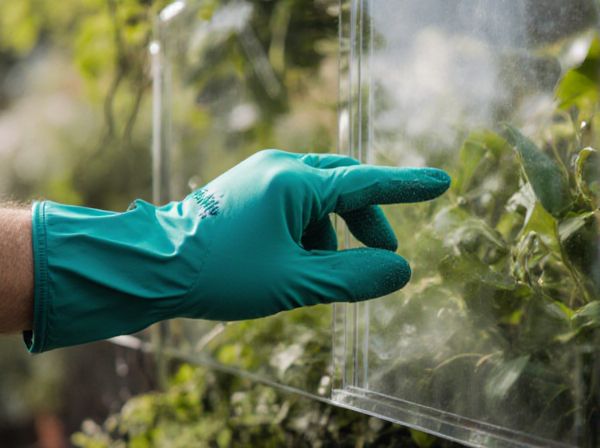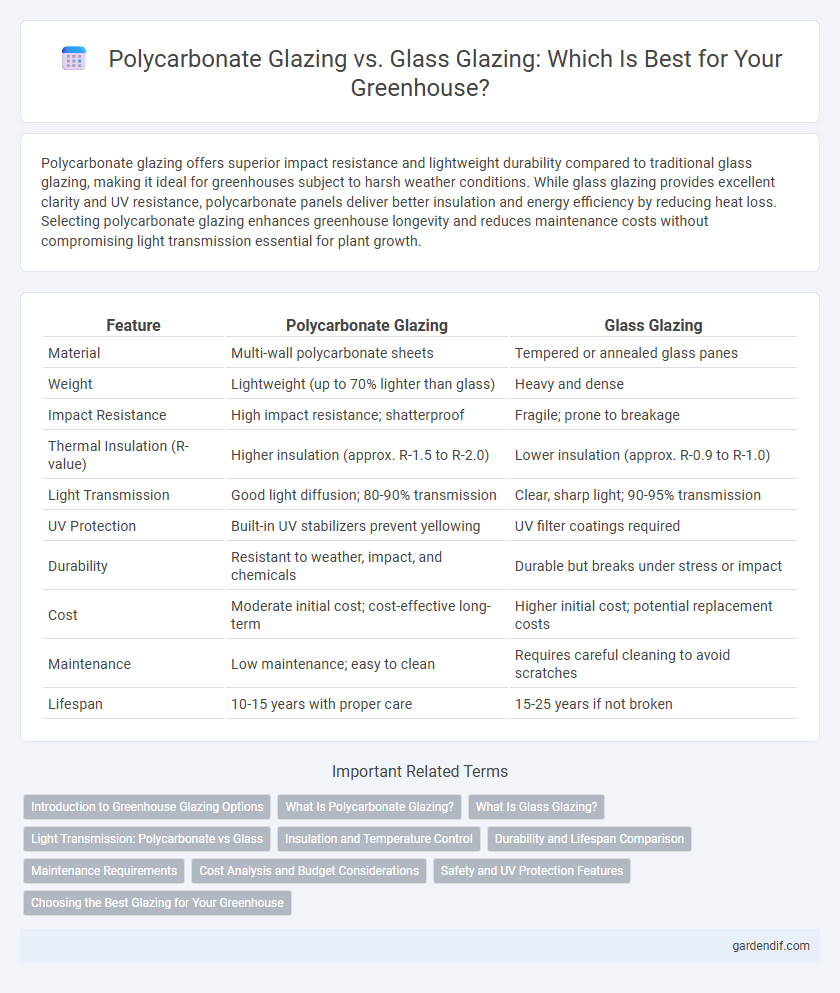
Polycarbonate glazing vs Glass glazing Illustration
Polycarbonate glazing offers superior impact resistance and lightweight durability compared to traditional glass glazing, making it ideal for greenhouses subject to harsh weather conditions. While glass glazing provides excellent clarity and UV resistance, polycarbonate panels deliver better insulation and energy efficiency by reducing heat loss. Selecting polycarbonate glazing enhances greenhouse longevity and reduces maintenance costs without compromising light transmission essential for plant growth.
Table of Comparison
| Feature | Polycarbonate Glazing | Glass Glazing |
|---|---|---|
| Material | Multi-wall polycarbonate sheets | Tempered or annealed glass panes |
| Weight | Lightweight (up to 70% lighter than glass) | Heavy and dense |
| Impact Resistance | High impact resistance; shatterproof | Fragile; prone to breakage |
| Thermal Insulation (R-value) | Higher insulation (approx. R-1.5 to R-2.0) | Lower insulation (approx. R-0.9 to R-1.0) |
| Light Transmission | Good light diffusion; 80-90% transmission | Clear, sharp light; 90-95% transmission |
| UV Protection | Built-in UV stabilizers prevent yellowing | UV filter coatings required |
| Durability | Resistant to weather, impact, and chemicals | Durable but breaks under stress or impact |
| Cost | Moderate initial cost; cost-effective long-term | Higher initial cost; potential replacement costs |
| Maintenance | Low maintenance; easy to clean | Requires careful cleaning to avoid scratches |
| Lifespan | 10-15 years with proper care | 15-25 years if not broken |
Introduction to Greenhouse Glazing Options
Polycarbonate glazing offers superior impact resistance and thermal insulation compared to traditional glass glazing, making it a durable and energy-efficient choice for greenhouse construction. Glass glazing provides excellent light transmission and a classic aesthetic but is more fragile and less insulating than polycarbonate panels. Choosing between polycarbonate and glass glazing depends on factors such as budget, climate, and desired greenhouse performance.
What Is Polycarbonate Glazing?
Polycarbonate glazing is a lightweight, durable alternative to traditional glass used in greenhouse construction, renowned for its high impact resistance and excellent thermal insulation properties. It consists of multiple layers of polycarbonate sheets that provide superior UV protection and reduce heat loss, enhancing energy efficiency in controlled environments. Unlike glass glazing, polycarbonate is less prone to shattering, offering increased safety and longevity in harsh weather conditions.
What Is Glass Glazing?
Glass glazing in greenhouses refers to the use of transparent or translucent glass panels for covering the structure, providing excellent light transmission essential for plant growth. It offers superior clarity, durability, and resistance to scratching and yellowing compared to other materials. Despite higher costs and fragility concerns, glass glazing ensures optimal thermal insulation and a longer lifespan, making it a preferred choice for professional horticulture.
Light Transmission: Polycarbonate vs Glass
Polycarbonate glazing offers light transmission rates between 80% and 90%, slightly lower than glass glazing, which transmits about 90% to 95% of natural light. Despite its marginally reduced transparency, polycarbonate provides superior impact resistance and UV protection, making it advantageous for greenhouses exposed to harsh weather. Glass glazing, while allowing maximum natural light for photosynthesis, is more fragile and can lead to higher maintenance costs in greenhouse structures.
Insulation and Temperature Control
Polycarbonate glazing offers superior insulation compared to glass glazing due to its multi-wall structure, which traps air and reduces heat transfer, helping maintain a stable internal temperature in greenhouses. Glass glazing, while providing excellent light transmission, often requires additional insulation measures to prevent heat loss and temperature fluctuations. Enhanced temperature control with polycarbonate minimizes heating costs and improves plant growth conditions by reducing cold drafts and heat buildup.
Durability and Lifespan Comparison
Polycarbonate glazing offers superior impact resistance and can withstand extreme weather conditions without cracking, making it more durable than traditional glass glazing. Polycarbonate panels typically have a lifespan of 10 to 20 years, while glass glazing can last 15 to 30 years but is more prone to breakage and chipping. The enhanced durability of polycarbonate reduces maintenance costs and replacement frequency in greenhouse applications.
Maintenance Requirements
Polycarbonate glazing in greenhouses offers superior durability and impact resistance compared to glass, significantly reducing maintenance needs related to breakage and replacement. Its lightweight nature also minimizes stress on greenhouse structures, lowering costs for repairs and upkeep over time. Glass glazing, while offering excellent clarity, requires more frequent cleaning and careful handling to prevent cracks and chips, which can increase long-term maintenance efforts and expenses.
Cost Analysis and Budget Considerations
Polycarbonate glazing offers a significantly lower initial cost compared to traditional glass glazing, making it an economical choice for budget-conscious greenhouse projects. Its lightweight nature reduces structural support expenses, further decreasing overall construction costs. However, glass glazing provides superior durability and longer lifespan, potentially lowering maintenance and replacement expenses over time.
Safety and UV Protection Features
Polycarbonate glazing offers superior impact resistance and shatterproof safety compared to traditional glass glazing, significantly reducing the risk of injury in greenhouse environments. Its inherent UV protection blocks up to 99.9% of harmful ultraviolet rays, safeguarding plants from UV damage while preventing material degradation. Glass glazing, while providing clear visibility, lacks the enhanced safety features and UV filtration efficiency found in polycarbonate panels.
Choosing the Best Glazing for Your Greenhouse
Polycarbonate glazing offers superior impact resistance and UV protection compared to glass glazing, making it ideal for greenhouses exposed to harsh weather. Glass glazing provides better clarity and longevity, allowing maximum light transmission for optimal plant growth. Choosing the best glazing depends on factors such as budget, durability requirements, and light intensity needed for specific plants.
Polycarbonate glazing vs Glass glazing Infographic

 gardendif.com
gardendif.com